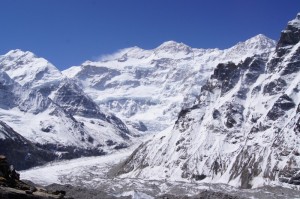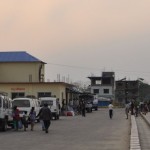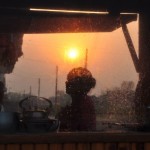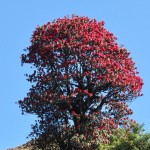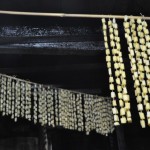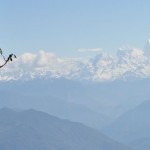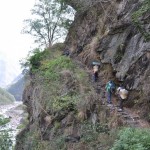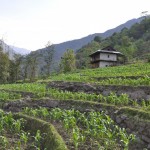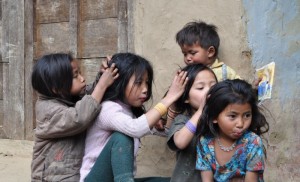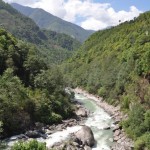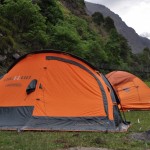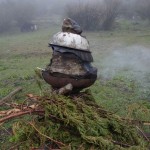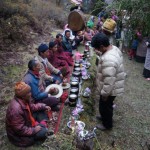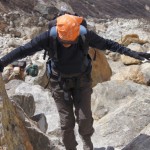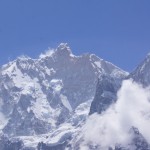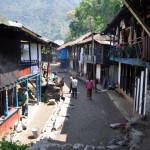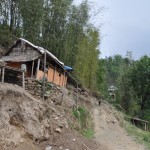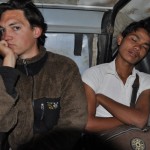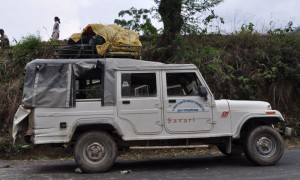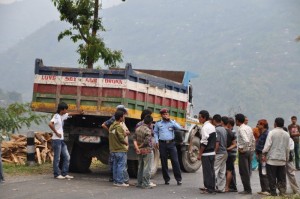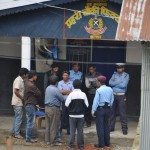I joined a 21-day off-beat trek (April 22 – May 12) to Kanchenjunga, the world’s third highest mountain at the border with India. Our party of six (two trekkers, a guide and three porters) had a most eventful trek. First, a strike by plantation workers at Ilam upset our plan to take a bus to Taplejung, the starting point of the trek. We wasted six days as a result and could not follow the circuit route as planned. Second, an accident occurred after the trek when a truck hit the rear part of our minibus and broke the right arm of one of the porters. Third, a strike in a nearby town prevented us from reaching the airport. We had to buy a new ticket to return to Kathmandu.
April 18 – 21: Kathmandu
I returned to Kathmandu with some of my Italian friends after the Mustang trek. I spent most of my time at a backpacker hotel in Thamel writing my travel notes and getting ready for the Kanchenjunga (Pang Pema) Base Camp. Though Himalayan Trailfinder advertised a 17-day trek to Kanchenjunga in March when Clifton (an American teacher) asked for this trek to be arranged. He later requested a 22-day circuit trek covering both the base camp at Pang Pema (north) and Yalung (south) i.e. Taplejung – Ghunsa – Pang Pema – Yalung – Taplejung. No one else was interested and I agreed to a 22-day circuit trek.
April 22 – May 12: 21-day Kanchenjunga (Pang Pema) Base Camp Trek
Day 1 (April 22, Friday): Kathmandu – Biratagnar – Birdmonde (by air and bus)
Accompanied by Maila, our guide, Clifton and I left Kathmandu for Biratagnar by air. It was a clear morning and I had a scenic 40-minute flight: I saw all the peaks including the Everest soar high above the clouds. We travelled by local bus and reached Birdmode at 2pm where we met our three porters, Khumbe, Prem and Krishna who had travelled there by local long-distance bus.
According to Maila’s plan, we would leave by local bus for Taplejung that afternoon. But nothing works as planned in Nepal! There’s a strike in Ilam by tea plantation workers who demanded a pay rise from 150 to 250 rupees a day (i.e. over US$3). They had blocked the road thus bringing the town as well as the region to a halt as buses/jeeps have to pass through Ilam to reach Talejung. Politicians and the government intervened and the locals said a solution might be available the next day. We were stuck and could do nothing but to wait.
Day 2-3: Birdmonde
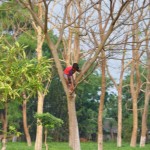 Clifton was restless after having finished reading his books. I took things easy and tried to make best use of the time preparing my travel notes and photos. As there’s no electricity after 9 pm, I went to bed early. I was awakened by shouts and bangs on the door around 10:30pm. Three policemen stormed in and I had to open my bags for inspection. Maila said that the town is not safe and policemen conduct such search for time to time!
Clifton was restless after having finished reading his books. I took things easy and tried to make best use of the time preparing my travel notes and photos. As there’s no electricity after 9 pm, I went to bed early. I was awakened by shouts and bangs on the door around 10:30pm. Three policemen stormed in and I had to open my bags for inspection. Maila said that the town is not safe and policemen conduct such search for time to time!
We got ready for departure at 5am on Day 3 only to be disappointed again. Both Clifton and I were so anxious to leave the boring town for the mountains that we were ready to pay 5000 rupees extra for a jeep ride. But no jeep driver was prepared to take the risk and there’s no indication when the strike would be over. Clifton was very frustrated as he must be back to Kathmandu on May 14 to catch his flight. I was more relaxed as I had nothing fixed.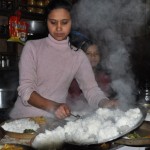
Day 4: Birdmonde – Basantpur (by jeep)
There’s no bus service or news about the strike. Despite the availability of modern communications devices such as mobile phone, TV and radio, no could tell us what’s happening.
After reviewing the options, we decided to take a jeep to Basantpur (2200m) to start our trek to the north base camp though we had to pay 4000 rupees each for the ride. As we had already lost three days, we had to drop the idea of going to both the north and south base camp. We thus went back to square one i.e. we could only go to the north base camp.
We set off at 11am. The young driver was anxious to get another tank of diesel and stopped at half a dozen gas stations. Finally he got some from a shop selling accessories for vehicles. At 2pm we finally reached the road leading up to Basantpur. We passed Dhadukta and Hile and reached our destination at 5:30pm.
Day 5 (April 26, Monday): Basantpur – Chauki – Gupa Pokhari (16km; 9 hrs) (Tea house)
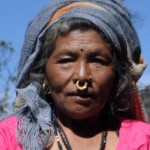 Before the opening of a road to Talejung, the trek to Kanchenjunga normally began in Basantpur and would take 10-12 days to reach the north base camp and complete the trek in about 18 days. As we had already lost so much time, we planned to complete the trek in 15 days i.e. April 26 – May 10.
Before the opening of a road to Talejung, the trek to Kanchenjunga normally began in Basantpur and would take 10-12 days to reach the north base camp and complete the trek in about 18 days. As we had already lost so much time, we planned to complete the trek in 15 days i.e. April 26 – May 10.
We set off at 7am. A Nepali woman asked me ‘tapanhiko chhro ho?’ i.e. ‘whether Clifton is my son’. I jokingly say ‘yes’. The path is well-defined with good views. We reached Door Pani (2780m) and descended to Chauki (Alt 2680m), a beautiful and clean village before noon. Our cook prepared a nice lunch in a tea house which is very clean. I particularly like the back yard which is filled with home-grown vegetables.
We continued at 1:30pm with many ups and downs. It started to rain heavily around 4pm followed by a hailstorm when we were just over 1km from Gupa Pokhari (2890m). We were wet and cold when arriving at a tea house. I had my first tonga (from fermented millet in hot water) and the local cheese which is fresh and delicious. The owner put the cheese cubes in a string and hanged the strings on the ceiling for drying. The wife of the owner asked a young girl of two to call me ‘ hajurama’ i.e. grandmother! I am really getting old and must look aged!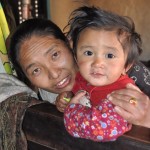
Day 6: Gupa Pokhari – Nesum (13km; 7hrs) (camping)
We arrived at a check-point at 7:45am and had my first sight of Kanchenjunga. We walked through forests with many ups and downs. I fell four times as the path was muddy and slippery. We stopped before 11 am at a hut in the middle of nowhere to have noodle soup for lunch. We resumed at 11:45am and walked for a couple of hours without passing another village.
It started to rain around 3pm and we finally reached a very rustic mud house by the path at Nesum (1620m) around 4pm. Maila set up two tents for us at a public path and many children gathered around the tents. Clifton, who is a teacher, enjoyed talking with the kids.
We met four trekkers from Australia who had just completed a 28-day circuit covering both the north and south base camp. The bus service to Ilam apparently resumed after a 6-day strike i.e. from April 21 to 26. I believe we had made a right decision to leave Birdmonde. First no one could predict the end of the strike. Second, the trek from Basantpurn is scenic with beautiful valleys and villages, rhododendrons (Nepal’s national flower) in bloom and forests.
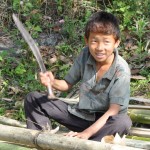 |
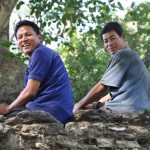 |
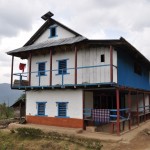 |
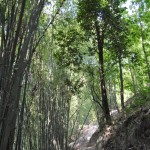 |
Day 7: Nesum – Dobhan – Mitlung (16km; 7 hrs) (tea house)
We zigzagged downhill to reach Sobuwa Khola, crossed the first suspension bridge on this trek to reach Dobhan (640m) where we had lunch. We remained on the east bank of the Tamur Koshi all the way to Mitlung (880m).
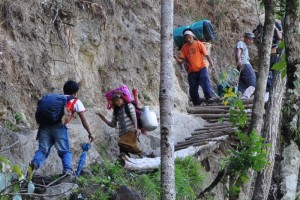 |
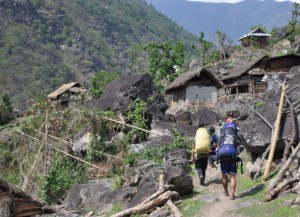 |
We walked next to the river bank filled with boulders of all sizes and sandy strips or through terraced fields on the hillside or in a forest. There are several sections of the trek which are dangerous and difficult as a result of serious landslides. I worry about the safety of porters who carry heavy loads on their heads.
It started to rain heavily some 30 minutes before we arrived at Mitlung. The boulders with mosses got very slippery and I fell badly on a couple times again. I was so wet and hot that I took a cold shower once I arrived at the tea house. The porters had a trying time and I brought them tongba.
Day 8: Mitlung – Sinwa – Chirwa (10km; 7 hrs) (tea house)
We continued along the east bank of the river. Condition of the path is better. We stopped at Sinwa for lunch and spent the night at Chirwa (1190m), a hidden village behind some huge boulders. The village looks shabby and there are many young children. I saw four girls picking hair lice from each other and small children carrying their baby brothers and sisters on their back. I was told most families have at least six children. I feel sorry for the kids and am not certain about their prospects.
Day 9: Chirwa – Sakathum (6km; less than 5 hrs) (camping)
We followed the Tamur Koshi to the confluence with Ghunsa Khola. The trail is good and we arrived at Tapethok (1320m) where there is a national park check-point. We crossed the bridge and walked on the west bank of the river. After crossing another bridge, we followed the narrow Ghunsa Valley and stopped at Phembu for lunch and reached a beautiful camp site at Sakathum (1640m) around 2 pm.
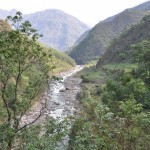 |
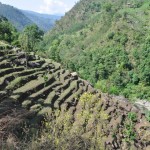 |
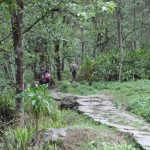 |
We had an easy day. The weather was good and I could see Jannu (7710m) at the end of the Ghunsa valley. A group of 10 young porters (five girls and five boys) carrying goods to Ghunsa arrived around 5pm. Porters earn about 2000 rupees for carrying a load of goods of 75kg from Taplejung to Ghunsa. They walk fast and may take 3-4 days to reach Ghunsa. Girls carry a lighter load which may still weigh some 50kg. I wish something can be done to protect the interest and health of the porters. They deserve a better pay for their hard labour. In any case, a weight limit can be imposed to protect them.
Day 10 (May 1): Sakathum – Ghaiyabari – Thyangyani (13km; 7 hrs) (tea house)
I got up before 5am, took a picture of Jannu and watched the porters leave with their heavy load at dawn. My battery went flat and I could not take pictures till I recharged it in Ghunsa.
We continued our trek with many ups and downs along the narrow Ghunsa valley. The first part of the path lined with bamboos with stone steps is nice and cool. We had lunch at Ghaiyabari (2150m). There are some large pink roses with a strong and sweet scent! After that, the trail is dangerous and steep with many ups and downs. I had to take extra care because of my knee problem. Condition of the path improved later and we reached a crest at 2530m before descending to Amjilosa (2490m). There are more stone steps and a nice clear path leads to Thyangyani (2410m).
We met the group of porters again at a tea house in Thyangyani. As it was raining and my tent was wet, Maila arranged me to sleep indoors while he and one of the porters stayed in the tent. I got a quiet corner while the 10 porters slept on the floor with girls on one side and boys the other. Each group was covered by two thin blankets and they cuddled together to keep warm. Though they did not make much noise, I could not sleep.
Day 11: Thyangyani – Gyabla – Phole – Ghunsa (12 km; 7 hrs) (tea house)
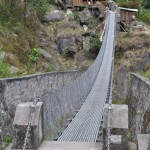 We followed the Ghunsa Khola and stayed on the north bank all the way to the bridge at Ghunsa. The trek is pretty and not difficult. But as usual we climbed by 100 to 300m and then dropped all the way down to the river. We had an early lunch at Gyabla (2730m) which is peaceful with plenty of rhododendrons, apple trees, barley and potatoes fields. The mountains on the opposite side of the river seem very close!
We followed the Ghunsa Khola and stayed on the north bank all the way to the bridge at Ghunsa. The trek is pretty and not difficult. But as usual we climbed by 100 to 300m and then dropped all the way down to the river. We had an early lunch at Gyabla (2730m) which is peaceful with plenty of rhododendrons, apple trees, barley and potatoes fields. The mountains on the opposite side of the river seem very close!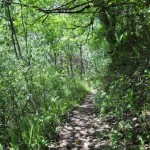
After lunch, we had a couple of ups and downs before reaching Phole (3210m), a large pretty settlement with plenty of yak pastures and potato fields, large stone houses and several tea houses. We had a nice cup of tea before heading to Ghunsa (3515m). The path is good with gentle ascents and descents and the weather stayed fine most of the day. The tea house where we stayed is comfortable and clean. I paid 200 rupees for a hot shower which was my first hot shower since leaving Kathmandu on April 22 (I had cold shower almost every day!)
As there is hydro-power in the area, I had my camera and computer battery recharged. The village with some 60 houses and 200 inhabitants resembles Namche Bazaar in the Khumbu region serving as the springboard to Kanchenjunga. But it looks peaceful, more authentic, intimate and pristine with traditional wooden houses with fenced fields for yaks or cultivation.
Day 12: Ghunsa – acclimatisation/rest day (tea house)
Today’s the most relaxing day of the entire trek. I met four Japanese trekkers who were on their way to the base camp. Supported by a team of 19 porters, they had tried to climb Ramtang (6601m) without success as there was too much snow.
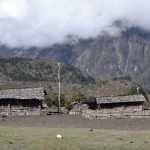 |
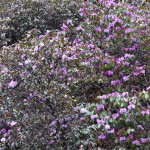 |
The village was celebrating the ‘Chorten Remong’ festival which is held once every four years for the dead. I watched a dozen of villagers, young and old led by the chief lama walking around the village. Each of them carried a wooden case containing sutra books which are stored in the monastery/temple. The procession stopped on several occasions where the chief lama performed some ceremony to bless the family while the villagers gathered around chanting. They served the chief lama and other monks with tongba. They looked amused to see me and Clifton follow them around and take pictures. The women gathered in a kitchen to prepare tongba when I popped in. They laughed at me and offered me two flasks of tongba. Fortunately, I did not get drunk!
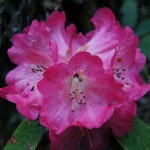 |
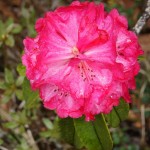 |
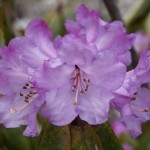 |
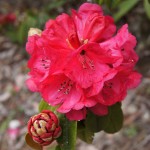 |
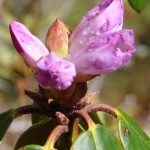 |
Day 13: Ghunsa – Khambacken (7km; 5 hrs) (camping)
I walked leisurely for about two hours on the east side of Ghunsa Khola going through a pine open forest. There are also plenty of larch, juniper, rhododendrons and wild spring flowers. Dozens of landslides of all scales have resulted in boulder-strewn floodplains along the river.
We crossed a bridge and stayed on the west side of the river. We had lunch at Rambuk Kharka (3720m) and continued our ascent to Khambacken (4150m). The path is pleasant and generally not difficult. But there are two sections with very serious landslides. I had to take extra care and used my hiking poles on the fairly steep and unstable screed slope.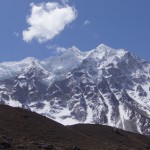
The landscape and scenery gets more impressive as we moved towards our destination. Jannu Glacier facing Khambachen hangs high up above the river valley with a sheer drop to Ghunsa Khola. On the south side of the glacier stands three giant mountains clustering together with towering peaks – Khabur (6332m), Phole(6645m) and Jannu (7710m). The Merra Peak (6344m) stands out between the Ramtang Glacier and Jannu Glacier. As the temperature drops considerably, Maila put a cover over the tent. As a result, the tent remained nice and warm and I had a good sleep.
Day 14: Khambachen – Lhonak (5km; 4 hrs) (camping)
I slept well and got up before sunrise. I climbed up the ridge south of Nupchu Khola and had majestic views of the towering peaks and a close look at the enormous Jannu Glacier. We had an early start and climbed gradually across the screed slopes (some 500m) which affords superb views of the towering peaks. With my knee problem and clumsy legs, I took every step with caution!
Above Ramtang (4350m), the trail runs along the lateral moraine of the Kanchenjunga Glacier, following the north bank of the river to mouth of the Lhonak Glacier. We arrived at Lhonak (4790m) at 1pm. Views from Lhonak in all directions are fantastic – Kanchenjunga Glacier and Chang Himal ( Wedge Peak at 6750m) on the south side, Chulima Himal to the west, Janak Himal to the north and Jorkiy Himal to the east with numerous stunning peaks of 6000-7000+ metres.
We had a late lunch and a relaxing afternoon. I talked with the Japanese trekkers whom I had met at Ghunsa. One of the trekkers has been in Nepal 18 times and climbed Everest in 2000 with five Japanese climbers at the cost of around US$60,000 each. He said he would return to climb Kanchanjunga one day.
The sky turned black and a snowstorm suddenly appeared. I was excited and took many pictures of a herd of some 50 blue sheep in the storm and the ever – changing scenery with snow, clouds and sunshine. We had an early dinner and I went to bed as we had to get up at 5am to start our ascent to Pang Pema.
Day 15 (May 6): Lhonak – Pang Pema – Lhonak (10km; 6 hrs) (camping)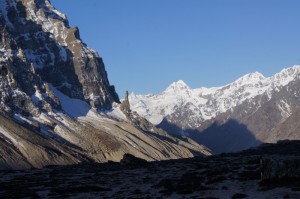
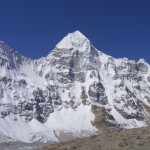 It was a beautiful and clear day. We set off before 6am and followed the trail ascending gradually across the plain and followed the line of the moraine. There are two parts with landslides and unstable slopes. We finally reached Pang Pema around 9am.
It was a beautiful and clear day. We set off before 6am and followed the trail ascending gradually across the plain and followed the line of the moraine. There are two parts with landslides and unstable slopes. We finally reached Pang Pema around 9am.
We had Tibetan bread and sandwiches and enjoyed some of the most spectacular mountain scenery on earth with the massive Kanchenjunga with its peak at 8586m, Kanchenjunga (Centre) at 8473 and Kanchenjunga (South) at 8476m rising steeply at the end of a glacier. Kanchenjunga is flanked by mountains on both sides with Kangbachen (7903m) and Yalung Kang (8505m) on its left and Gimmigela Chuli (The Twins) (7350m) and Nepal Peak (7168m) in front on its right. One can only have a full view of Kanchenjunga upon reaching Pang Pema which has a couple of stone houses for trekkers. Standing at some 5200m, I could not take my eyes off Kanchenjunga, which is massive, gigantic and yet so close. It definitely is awesome and has a presence.
Day 16: Lhonak – Ghunsa – Phole (15km; 8hrs) (camping)
We got up very early as Maila thought the snow would be coming. We left at 6:45am taking the same path all the way to Ghunsa. The weather stayed fine and we had good views of the mountains. On the way back, I took pictures of a major landslide before reaching Khambachen and two serious ones from Khambachen to Ramtang. The landslide situation on the east bank of the river from Ramtang to Ghunsa is no better. There are several major ones and numerous minor ones. I hate climbing up and down the boulders as it’s tiring for my legs and knees. It took me three hours to reach Ghunsa.
After lunch, we departed for Phole at 3pm and arrived at the campsite at 4:30pm. It started to rain heavily. We were better prepared and my tent remained dry.
Day 17: Phole – Thyangyani – Lamatang (8 hrs) (tea house)
We set off at 7:15am, arrived at Thyangyani for lunch at 12:30pm and reached Lamatang at 5pm.
Shortly after leaving Phole, I took the wrong turn. Instead of taking the path down to the river, I went up and got lost in a forest. Maila went all the way back to Phole to look for me! We ascended some 200 to 300m before descending to the river side and had four ups and downs altogether. The path is pleasant and pretty with bamboos on the side with lots of rain and long yellow grass on the slopes in a rain shadow.
I find the part of the path to Lamatang steep and slippery. It started to rain heavily around 4pm and I slipped a couple of times. Though the path is not too long, I walked so slowly that I arrived at the tea house after 6pm.
We slept in the living room while the local family and friends were drinking ‘chan‘ (a home-made wine from rice), dancing and chatting loudly. I could not sleep till everyone’s gone and the lights off.
Day 18: Lamatang – Phembu – Sinwa (9 hrs)
The walk from Lamatar to Sakathum is relatively short and easy. After a nice cup of tea, we continued and reached Phembu for lunch. We resumed trekking before 1pm and the path is fantastic, well paved with stones all the way and along the river. I passed through the same path on Day 9 but seemed to rediscover its beauty!
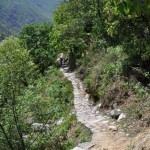 |
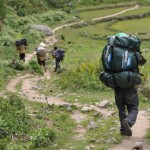 |
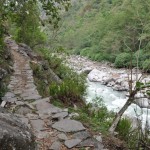 |
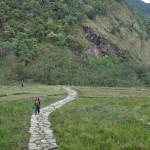 |
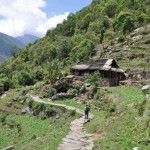 |
Once again we had to cross the river at Tapethok and walked along the river. I was so hot that Maila brought me a cold fizzy drink in Chirwa, the first one I had on this trek. The walk is not difficult but long and I finally reached Sinwa at 6:30pm. We had daal baht at the tea house.
Day 19 (May 10, Monday): Sinwa – Mitlung – Taplejung (less than 6 hrs) (End of trek)
Sinwa is a busy and noisy place. I had chapati for breakfast for a change. We set off at 7am and arrived in Mitlung within 90 minutes. Prem prepared rara noodle soup and we set off again at 10am. We took a new path to Taplejung. There is a steep climb of some 400m first followed by another straight climb of 600m for an hour and a half. The path which is heavily used is very steep and badly eroded with houses built close to the path which does not look safe.
There’s no wind and the air was humid and hot. I was relieved when I reached the top of the ridge around 12 noon. The subsequent 2-hour walk to Taplejung is easy without ups and downs. It rained heavily but stopped after ten minutes. My clothes were dried before we reached our tea house at 2pm. I was relieved that the trek is finally over. We had an end of trek feast with 2kg of chicken meat. I treated the team with beer and raksi.
Day 20: Taplejung – Birdmonde (by minivan)
We all thought our trek and adventure were over. But it turned out to be a day of horror as a result of an accident.
We had to get up at 4am in order to take the jeep leaving for Birdmonde at 6am. The journey takes 10-12 hours. In Nepal, jeeps are normally packed and some may sit on the roof or standing on the side. Our jeep carried 15 passengers and Clifton, Maila, Khumbe and I sat at the back (two on each side).
Around 12:30pm, I suddenly felt the jeep was swinging and saw the plastic cover on the right side of jeep being slashed away. Then I saw blood splashing in all directions and Khumbe’s right arm all covered in blood. Khumbe started to scream in pain. The jeep stopped and Maila helped Khumbe to get out. Clifton sitting next to Khumbe was shocked as he was covered in blood. He thought he was injured and touched his limbs. I covered my eyes with my hands as I did not want to see. The bad memory of my accident in Zanzibar when falling glass from a shower cabin had cut my wrist and the bathroom was covered in blood haunted me. Maila applied first aid and luckily an ambulance passed by within a few minutes and rushed Khumbu accompanied by Maila to a hospital. Clifton and I left with the driver and other passengers. But none of them speaks English.
I later discovered what had happened. A big truck came towards our jeep and hit the right rear corner where Khumbe had his right arm resting on a rail. Clifton told me that he also had his arm on the rail and somehow he seemed to hear a voice telling him to take his arm off the rail just a few minutes before the accident. What a narrow escape!
The police arrived some 90 minutes later. Then our jeep and the truck drove to a police station and we spent another hour without a clue what’s happening. I was anxious about Khumbe’s safety. We finally arrived in Birdmonde at 7pm and got a call from Maila who was with Khumbe in a regional hospital. Khumbe has broken his arm and had an operation. Maila said Clifton and I could return to Kathmandu as scheduled while the two porters would take the long-distance bus. He would stay with Khumbe till he’s fit for travel.
When I tried to download the memory card to my computer, I found to my horror that the card was corrupted and all the pictures on the best part of the trek i.e. from Ghunsa to Ghunsa had gone. Clifton kindly let me have his pictures.
Day 21 (May 12): Birdmonde – Bhadrapur – Kathmandu (by jeep & by air)
Maila called and asked us to settle the bills first and give some money to the porters so that they could return to Kathmandu. Then the bad news came that there’s a strike in Ileria, Chitwan and Biratanagar and we could not go to the airport. More cities would be on strike the following day. We were frustrated and felt stuck again.
We were on the phone with the management of the company to find a solution. Basanda and his staff were most helpful. They changed our flight so that we could depart from Bhadrapur at 1pm instead of from Biratanager. We had to pay 1800 rupees each for a jeep and some US$40 more for the new ticket. I would pay everything reasonable to get back to Kathmandu. The plane took off on time and we finally arrived in Kathmandu at 2:30pm.
Clifton and I spent the rest of the afternoon recounting the accident and our trek. We went to the Everest Steak House to treat ourselves with a huge steak. We enjoyed the juicy and tender steak after having daal bhaat for over three weeks.
May 13 -14: Kathmandu
There was a strike in Kathmandu on May 13 and Thamel was dead with most shops and restaurants closed. I was fed up as strikes seemed to take place anytime. I decided to travel overland to Tibet and arranged a private car to take me to Kodari on May 15. Then the news came that there would be another strike on May 15 and drivers might not wish to go. Nothing could be confirmed till 9-10 am on May 15!
I did not bother to pack till I had a firm indication. Then at 9:30am, a driver suddenly turned up in my hotel and said the car’s ready! I packed and set off at 10am. I gave a lift to a Spanish lady who wanted to go to Bhaktapur but could not find a car. My driver had to detour to avoid the crowd in a couple of places. We gave lifts to a dozen people on the way and I arrived in Kodari before the immigration office closed at 3:30pm. I walked across the Friendship Bridge which spans the Bhote Koshi and entered the Chinese soil ending my 51 days’ stay in Nepal.
Remarks
This is my third visit to Nepal. I have many unexpected experiences and a closer look at Nepal today.
First, it’s a pity that the strike at Ilam had upset my plan to do a circuit trek of Kanchanjunga. This trek has few trekkers and the experience is totally different from the Everest trek.
Second, Mustang was not on my list. But this trip with my Italian friends is most memorable and enjoyable. I plan to return to Mustang next year.
Third, I find Nepal a dysfunctional country with too many problems. The people are nice, happy and hard-working people. But their daily life is made more difficult by power-cuts, pollution, insufficient infrastructure and social services, frequent strikes etc. Conditions of roads are generally poor. The men in the street are fed up with the politicians but there is not much they can do!
Fourth, erosion and landslides are serious problems. But given the pressure of the population on land for cultivation and housing and lack of pro-active land-use planning and effective control, the problem of erosion and land preservation cannot be dealt with.
Fifth, people, young and old, do not seem to care much about the environment. I find their habit of littering horrifying.
Lastly, population increase is another problem. I am concerned about the children’s future.
What can be done and should be done? Can Nepali politicians and the people work together to find practical solutions? I am not sure but wish them luck!


